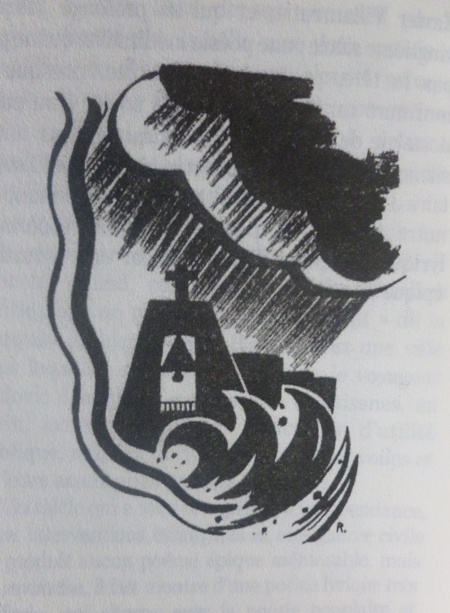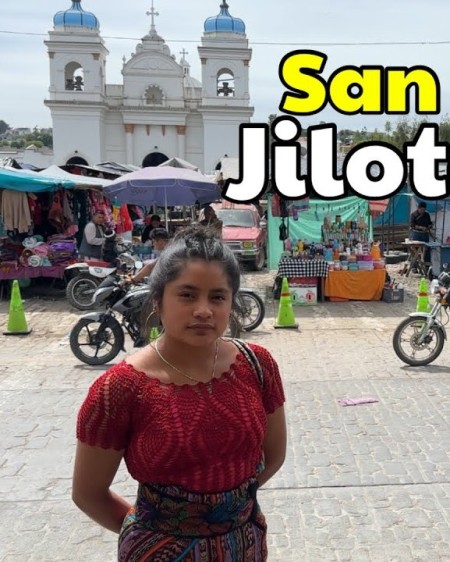Multiples adventures
Dominicans and Franciscans in Maya land - XVIth century
A trip by Las Casas to Tabasco and Chiapas
Pedro de Barrientos in Chiapa de Corzo
Las Casas against the conquistadores
Fuensalida and Orbita, explorers
Numerous studies
An ethnologist friar, Diego de Landa
Two teachers, Juan de Herrera and Juan de Coronel
Two historian friars, Cogolludo and Remesal
A multitude of buildings
A Franciscan turned architect: Friar Juan de Mérida
The Valladolid convent in the Yucatán
The Izamal convent and its miracles
In the Yucatán, a church in every village
A Dominican nurse, Matías de Paz
A difficult task: evangelization
The creation of the monastery of San Cristóbal
The Dominican province of Saint-Vincent
An authoritarian evangelization
Franciscans and the Maya religion
The failure of the Franciscans in Sacalum, the Yucatán
Domingo de Vico, Dominican martyr
The end of the adventure
Return to the monasteries
Additional information
The Historia Eclesiástica Indiana of Mendieta
The road of Dominican evangelization in Guatemala
The convent of Ticul, as seen by John Lloyd Stephens
The Franciscans in the Colca valley in Peru
The convent route of the Yucatán in the XVIth century
The dominican mission of Copanaguastla, Chiapas
Available upon request: -
general information upon Maya countries, - numbered texts
on the conquest and colonization
of Maya countries
Address all correspondence to:
moines.mayas@free.fr
|
RETURN TO THE MONASTERIES?
|
Drawing by Fermín Revueltas in Ramón López Velarde's "Zozobra", 1919
After an adventurous life, return to the monasteries?
The religious orders, Franciscans and Dominicans, supervised the life of the majority of the Mayan population until the secularization of the doctrine, when the administration of parish affairs was turned over to the secular clergy.
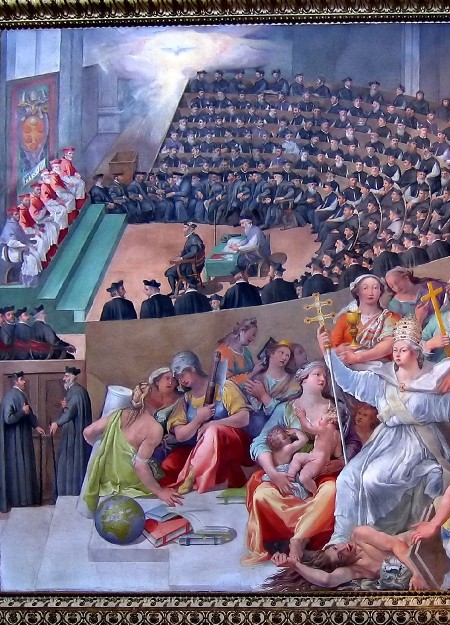
The Council of Trent, Pasquale Cati, 1588, Santa Maria in Trastevere, Roma
The Council of Trent (1545 to 1563) strengthened the bishops' power in such matters as the visitation of all chapters and monasteries within their dioceses, the correction of secular clerics and regulars monks there who are not living within a monastery, friars being henceforth prohibited from preaching without the bishop's license in any churches but those of their own order.
The Council admitted that the mendicant missionaries, Franciscans and Dominicans, had done much for the christianization of the Indians and that he could do very little without them, for he felt that they had gained too much power. In Yucatán, Chiapas and Guatemala, the secular clergy worked hand in hand with civil authorities, while the missionary friars, laboring independently, tended to have greater influence over the Natives.
According to the Council, the doctrinas, which were administered by the friars, should be placed under the jurisdiction of the bishops. In this way, the bishops would be able to replace friars with secular clerics.
But not until the end of the colonial period, however, did the Tridentine reforms affect the Franciscans and the Dominicans in southeast Mexico. They continued in charge of a number of parishes, largely because of the scarcity of secular priests who could hardly be attracted to the remote pueblos de indios where it was difficult to make a living.

The monastic orders in Maya lands and beyond: 2022, July, opening celebration of the "Franciscan common novitiate in Central America, the Caribbean and Mexico" by brothers from eight different countries
In 1583, the king of Spain, Philip II, sent a decree (cédula) to the bishops of Guatemala, to confirm the decisions of the Council:
The Friars set up evangelization on a temporary basis
“Father Alonso de Noreña did not enjoy much his last year as Provincial and the whole province worried a lot about several copies a royal decree that were sent to the bishops of the region, and that said “
“The KING. From our Counsel to the father bishop of Guatemala in the name of Christ. You already know that, in accordance to what was ordered and established by the saintly Roman Church and in accordance to the ancient tradition received and kept in Christianity, the administration of the saintly sacraments belongs to the clerks priests, within the parishes of the churches and according to the priests of the Orders which play the role of adjudicators for preaching and confessing. And that in the Indies, through apostolic concession, preaching and curies were the responsibility of the priests from the begging Orders because there was at the time a lack of clerks priests and a lack of their availability to deal with conversion of, preaching and teaching the Indians with the necessary zeal and efficiency, which in facts were the objectives by such disposition, and the results of which were in total conformity with what was desired and is still desired : the priests, with an apostolic life and saintly perseverance, obtained such good results that thanks to their preaching, with the grace and the help from our Lord, many a soul got to know Him.”
They must now leave their place to the priests and bishops
“But since this situation must now be brought back to its core principle, and must be much as possible restituted for the usual and normal use of the Church, as far as organizing the parishes and preaching are concerned, so that the Indians do not miss it, I beg you and request that from now on, if you have qualified clerks, you appoint them to the said curies, preaching and benefits rather than the Friars, while saving the order prescribed in the list established under our patronage for the appointments. And during the period when you would not have the necessary clerks for all preaching and benefits, you should share the remaining posts equally among the orders present in your provinces, so that there is a mix of everything, and so that each one works as he should and outdoes himself in this most saintly and apostolic exercise; and you will look after them, like a good pastor, so that your subordinates are motivated and so that the expected benefit is reaped by the Indians, thus relieving our conscience as well as yours. Done at Lisbon, on 29 January 1583. I, the King. On the order of His Majesty, Antonio de Eraso”.
“I do not know if any bishop from the provinces of the Government of Guatemala applied this decree and took a village from the priests to give it to the clerks to manage; on the contrary, they decided to alert His Majesty by informing him of the many serious drawbacks that his decision had raised and they awaited his confirmation before implementing the decision”.
(Friar Antonio de Remesal, History of the province of San Vicente de Chiapa y Guatemala, Book 11, chapter 5).

Antigua Guatemala, the archiepiscopal palace just restored, 2022
The bishops then try to limit the influence of the Friars
“Then the King our Lord appointed in his [Francisco Marroquín, first bishop of Guatemala, deceased in 1563] place Don Bernardino de Villalpando, bishop on the island of Cuba, or of Havana, who arrived promptly in Guatemala, displaying great authority, and accompanied by a numerous retinue and family. The Council of Trent had canceled many privileges of the begging orders: this Lord bishop, not only happy to suppress the privileges in question, prevented them from enjoying the remaining ones, on the basis of some obscure information which he interpreted to the detriment of the priests. But this prelate cannot be held solely the responsible party as many others, in the Church of God, acted in exactly the same way. […]
The very saintly Father Pie V drew up the list of all the humiliations and offenses inflicted by the bishops to the begging Friars; the bishop of Guatemala implemented them all, forgetting none, to the detriment of the Friars of Saint-Dominique and Saint-Francis who lived in his bishopric, taking away from the Franciscans the villages they were administering. […] The suffering they endured at that time was truly unbearable and they felt great pain. Their adversaries treated them with blatant injustice, behaving toward them like heretics rather than like people from the Church of God."
"The bishop was also extremely strict with the priests of Saint-Dominique. He prohibited father Friar Alonso de Villalva and others, I think, from preaching and hearing confession. He forbade the Indians from the countryside to come every Sunday to hear mass in the church or the chapel of the convent of Saint-Dominique, as they were used to, and made them go to the cathedral instead."
The market at San Martin Jilotepeque, 2024, August
"The persecutions he inflicted on the friars were so unbearable that they left town, abandoning the convent with the idea to settle in the village of San Martin, beyond Chimaltenango. But the inhabitants and chiefs of the town did not let them go and they came back to their monastery. They were very cautious not to allow the bishop to become exasperated but their zeal was useless and the slightest pretext was enough to spur trouble and defame them to the public. And his main occupation was to launch investigations regarding their behaviour, their life and their habits with the hope of finding something to kick them out of their ministry and to replace them with the clerks”.
(Friar Antonio de Remesal, General history of the West Indies and in particular the Government of Chiapa and Guatemala, Book X, Chapter XXI, translated by Chantal Burns).

Procession in front of The Dominican church at Guatemala City, Basilica of Our Lady of the Rosary (2024, October)
The friars manage to remain in the parishes of Chiapas and Guatemala
“The content and orientation of this royal decision (the cedule of 29 January 1583) was soon distributed among the priests, who became quite worried and feared losing their parishes and missions, since there were a high number of clerks available and ready to occupy them in the bishoprics of the kingdom. Their main goal was then to find a way to keep their dominant position, while they were aware that the royal cedule did not limit itself to the bishopric of Guatemala only, but could apply equally with the same arguments and consequences to the bishoprics of Chiapas, Nicaragua and Honduras. They tried every which way to postpone its implementation while in each community the most eminent and influential personalities were chosen to go to Spain and negotiate this state of affairs of the highest importance, and so it was done promptly. […]
“They discussed these projects among themselves, drafted long arguments and obtained letters of support addressed to the king from all the bishops operating in the cathedrals of our kingdom. The bishops themselves were priests (since, as we said, don friar Gomez Fernandez de Cordova occupied the see of Guatemala, don friar Geronimo de Corella the see of Valladolid de Comayagua in Honduras, and both were Hieronymite priests; don friar Pedro de Feria, from the order of the Preachers, occupied the see of Ciudad-Real de Chiapa and don friar Antonio de Zaya, from the order of the Minors of Saint-Francis, occupied the see of Leon de Nicaragua) and since they shared the same beliefs, they gave much support and strength to the project. The priests, having gathered the best means to succeed in their enterprise, and in conformity with their statues, appointed the persons who would go to Spain as a delegation, with the sole objective of succeeding in the negotiation. Among the most experienced fathers from the provinces who were elected to go were Friar Juan de Castro, from the province of Saint-Vincent of Chiapa and Guatemala of the Preachers, and Friar Bernardino Perez, from the province of the Name of Jesus of Guatemala of the Minors of Saint-Francis […]; and since they were eminent and respectable persons and led an exemplary life, as soon as they arrived at the Court, they were greeted very warmly during the audiences which the King gave them […]; the King, having consulted those who were most knowledgeable, ordered that a royal cedule should be sent, in which it was stated :
“ […] I have decided to write to you on this subject and therefore request that you gather several persons of your choice, […] to discuss all aspects of this problem and to propose solutions, and to send me a detailed report on the implementation of the cedule in question, with a list of the missions and villages of your province of Guatemala which are administered by the priests of all the different orders; […] and just as I am furthermore informing the prelates, I am asking you in the meantime to suspend implementation of the license and to leave the missions in the hands of the Orders and the priests, in all freedom and peace, so that they may keep as they did before the provinces they managed and should manage, without any new interference, including in the modalities of presentation and nomination ; […] At Aranjuez, 16 March 1586 – I, the King – on the order of his Majesty, Matheo Vasquez”.
“[…] But this cedule that we have just transcribed, while being favourable to the priests, now seems to me favourable also to the clergy, as some of its statements coincide with the orientations of the Saint Council of Trent
(Francisco de Fuentes y Guzman (1643-1700), Recordacion Florida, Part II, Book eleven, chapters X and XI, translated by Chantal Burns).
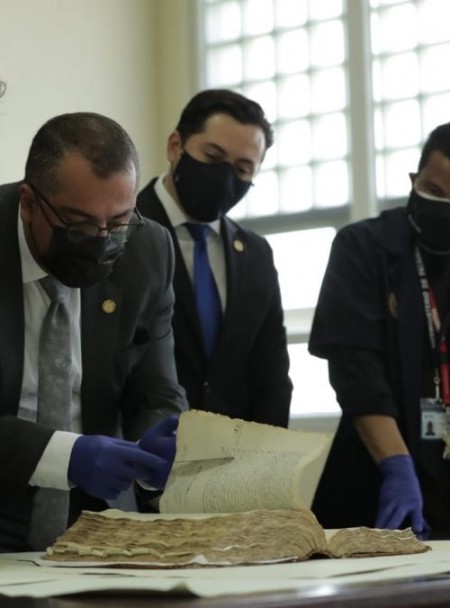
UNESCO registered the manuscript of Recordacion Florida by Francisco de Fuentes y Guzman in his "Memory of the World Register" (2021, april 16)
During his travel through Venezuela, in 1800, Humboldt ascertains the poder of the Monastic Orders:
"We had been recommended to the friars who govern the Missions of the Chayma Indians, by their syndic, who resides at Cumana. This recommendation was the more useful to us, as the missionaries, either from zeal for the purity of the morals of their parishioners, or to conceal the monastic system from the indiscreet curiosity of strangers, often adhere with rigour to an old regulation, by which a white man of the secular state is not permitted to sojourn more than one night in an Indian village. The Missions form (I will not say according to their primitive and canonical institutions, but in reality) a distinct and nearly independent hierarchy, the views of which seldom accord with those of the secular clergy."
(Travels to the Equinoctial Regions of America, During the Years 1799-1804, By Alexander von Humboldt and Aimé Bonpland, Chapter 6, Mountains of New Andalucia. Valley of the Cumanacoa. Summit of the Cocollar. Missions of the Chayma Indians.)
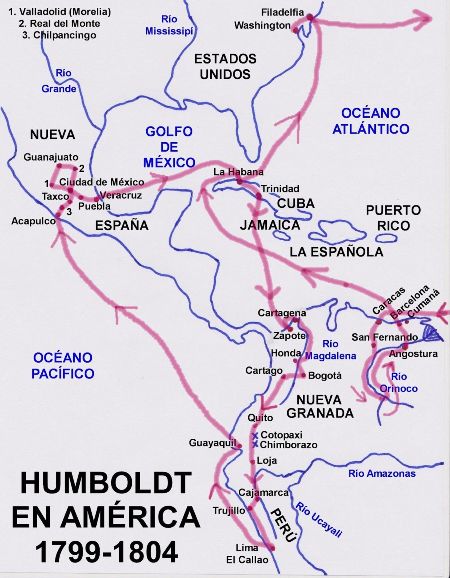
Humboldt's travels in America
From this time Mayan Indians inherited their catholic tradition. The dominant religion in Maya lands is still Roman Catholicism. And the most important icon of their culture is the Virgin of Guadalupe, which represents national identity as the product of the mixing of European and Meso-American religions and peoples. However, in recent decades, Protestant missionaries have been particularly active in southeast Mexico and among the urban poor.
Juan Diego meets the bishop of Mexico, Juan de Zumárraga, franciscan:
"170. And she ordered me to the top of the little hill where I had seen her before, to cut different flowers up there; Castilian roses.
171. And when I had cut them, I took them down to her at the bottom;
172. and she took them with her holy hands,
173. again she placed them in the hollow of my ayate,
174. so that I would bring them to you, so I would give them only to you.
.
175. Although I knew very well that the top of the hill isn’t a place where flowers grow, because there are only a lot of craggy rocks, thorns, spiny acacias, prickly pears, mesquite bushes. I didn’t doubt because of that, I didn’t hesitate because of that.
176. When I reached the top of the hill I saw that it was now paradise.
177. Every kind of different precious flowers were there, each one perfect, the very finest that there are, full of dew and shining so I immediately cut them;
178. and she told me that I should give them to you from her, and that in this way I would show the truth; that your should see the sign that you were asking for in order to carry our her beloved will,
179. and so that it will be clear that my word, my message, is truth,
180. here they are; please receive them."
181. And then he held out his white tilma, in the hollow of which he had placed the flowers.
182. And just as all the different precious flowers fell to the floor,
183. then and there the beloved Image of the Perfect Virgin Holy Mary, Mother of God, became the sign, suddenly appeared in the form and figure in which it is now,
184. where it is preserved in her beloved little house, in her sacred little house at Tepeyac, which is called Guadalupe."
(Nican Mopohua, writen in nahuatl by Antonio Valeriano in the middle of the XVIth century, published by Luis Lasso de la Vega in 1649)
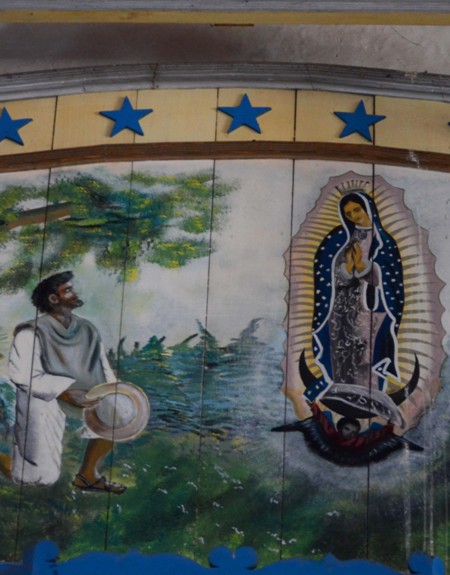
The apparition of the Virgin of Guadalupe to the Indian Juan Diego in 1531 (San Juan Chamelco church, Verapaz, Guatemala)
Four issues of Friars' relations:
Fray Diego de Landa, Relación de las cosas de Yucatán, Collección « Crónicas de América », Dastin, S.L., Polígono industrial Európolis, calle M.9, 28230 Las Rosas (Madrid), 2002.
Friar Diego de Landa: Yucatan before and after the conquest, translated by William Gates, Dover Publications, 31 East 2nd Street, Mineola, New York 11501, 1978.
Fray Antonio de Remesal. O. P., Historia general de las Indias occidentales y particular de la gobernación de Chiapa y Guatemala, Biblioteca Porrúa, Editorial Porrúa, Av. República Argentina, 15, 06020 México D.F., 1988. www.porrua.mx
Diego López de Cogolludo, Historia de Yucatán, Linkgua Ediciones S.L., Muntaner, 45 3° 1°, 08011 Barcelona, 2006.
Five web sites where one can find the texts:
Two books about conventual architecture:
Richard and Rosalind Perry, Maya missions, exploring colonial Yucatan, 2002, Espadaña Press, P.O. Box 30067 Santa Barbara, California 93130, Tel : 805 682-3664.
Richard and Rosalind Perry, More Maya missions, exploring colonial Chiapas, 1994, Espadaña Press, P.O. Box 30067 Santa Barbara, California 93130, Tel : 805 682-3664.

Mexican devotion: in Tizimin, Yucatan, the procession of the Three Kings, 2024, January 17
Address all correspondence to:
2025 "Friars
and Mayas"

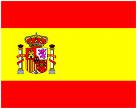

The tomb of Philip II in the Escorial
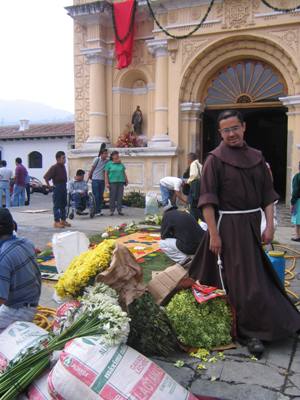
Antigua Guatemala. Franciscan friar in front of the church of San Pedro, constructed next to the Hospital of San Pedro in 1654.
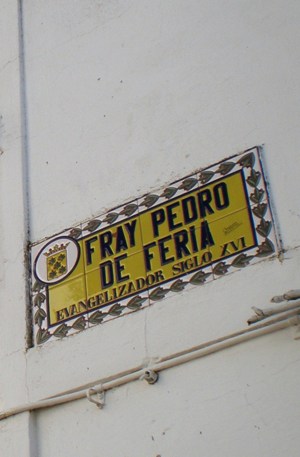
Fray Pedro de Feria, name plate in a street at Feria, Extremadura, Spain.
Pedro de Feria (1524-1588), Dominican friar, missionary with the Zapotecs Indians, then Provincial of the province of Mexico and Bishop of Chiapas during 14 years, till he died.
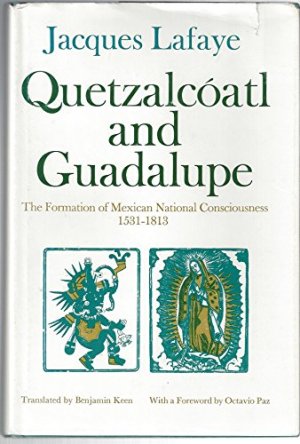
A great book: Jacques Lafaye, Quetzalcóatl and Guadalupe, the formation of mexican national consciousness (1531-1813), The University of Chicago Press, 1987
